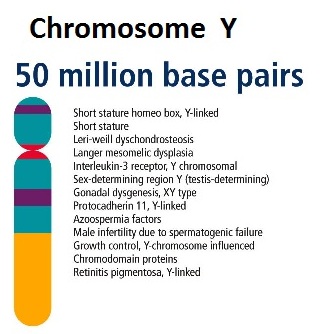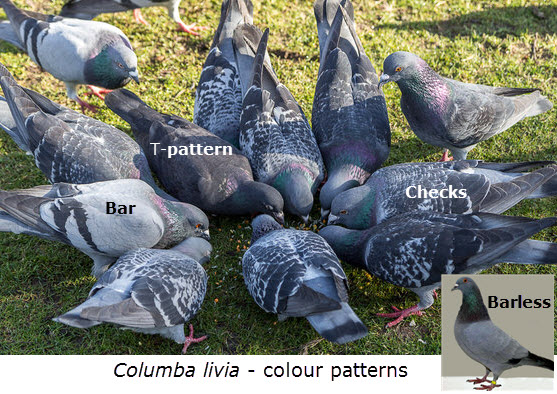Theoretical Genetics 2
 Multiple Alleles and Co-dominance
Multiple Alleles and Co-dominance
Beginning with a review of the punnet square questions from last lesson, students are then introduced to some more complex genetics using the example of human blood groups. Teacher led Description of ABO blood groups or studying the textbook on the alleles; IA IB i leads to two worksheets which support the teacher and students in answering questions about co-dominance and multiple alleles. To conclude the lesson there is a short video clip introduction to X and Y chromosomes and the inheritance of gender.
Lesson Description
 Guiding Questions
Guiding Questions
Can genes have more than two alleles?
Could the four colour forms of the pigeons Columba livia
be controlled by a single gene with two alleles?
Would you believe that there are thought to be as many as six alleles for a single gene for colour pattern in pigeons?
These alleles include: barless (c), bar (C+), checks (C) and T-pattern (CT).
Activity 1 Introduction to co-dominance and multiple alleles
One possible beginning for this lesson is to review the ![]() Theoretical genetics - Punnett square questions from last lesson. It is useful to be clear what genotypes, phenotypes, dominant and recessive alleles are, as well as gametes and F1 offspring.
Theoretical genetics - Punnett square questions from last lesson. It is useful to be clear what genotypes, phenotypes, dominant and recessive alleles are, as well as gametes and F1 offspring.
Alternatively an introduction to ABO blood groups (and the alleles IA IB and i ) will make a good fresh start and help students to understand blood group genetics as a nice example of co-dominance and multiple alleles.
Consider these questions while watching the video, Why do blood types matter? by Natalie S. Hodge on TedEd.
Questions to answer while watching the "Why do blood types matter?" video.
- Red blood cells, also called erythrocytes, have a complex protein on their cell membrane. What is it called?
- What does this protein on the cell membrane of erythrocytes tell immune cells?
- What are the two main blood type antigens?
- What are the three alleles of the blood type antigen gene?
- Which is the recessive allele?
- What are the four blood types?
- What happens to you if you only have group O alleles?
Complete the questions on the worksheet below. ![]() Simple blood group genetics theory worksheet.
Simple blood group genetics theory worksheet.
Activity 2 Further questions on multiple alleles and co-dominance
Complete the activity on the worksheet below. ![]() Further genetics questions on co-dominant and multiple alleles
Further genetics questions on co-dominant and multiple alleles
Activity 3: An introduction to the inheritance of sex in many species
This Youtube clip about XY inheritance in humans and ZW inheritance in birds from TEDeducation shows how X and y chromosomes result in male and female offspring in humans and that other animals use a variety of different mechanisms to control the sex of their offspring.
Teachers' notes
This lesson takes students to more complex ideas of genetics using human blood groups. There are a variety of ways to begin the lesson, including some lab work.
One good way to begin this lesson is to review the ![]() Theoretical genetics - Punnett square questions from last lesson.
Theoretical genetics - Punnett square questions from last lesson.
An alternative would be to use a simulated blood testing kit or the following activities from the Nobel prize website.
The worksheets are meant to help students to keep structured records of their learning and to help the teacher to explain the ideas..
There are many alternatives,
The two videos outline the two syllabus ideas about inheritance of gender and lead to the next lesson on sex linked genes.
This last video (![]() Fascinating but rather long explanation of the origin of the Y chromosome and it's genes.) is very interesting but goes beyond the syllabus statement which is to know that some genes are present on the X chromosome and absent from the shorter Y chromosome.
Fascinating but rather long explanation of the origin of the Y chromosome and it's genes.) is very interesting but goes beyond the syllabus statement which is to know that some genes are present on the X chromosome and absent from the shorter Y chromosome.
This excellent video![]() The genes you don't get from your parents about mitochondrial DNA is a nice revision of cell organelles and endosymbiosis, but what is most surprising is the genetic variation between mitochondrial DNA in our bodies. Very interesting and thought provoking.
The genes you don't get from your parents about mitochondrial DNA is a nice revision of cell organelles and endosymbiosis, but what is most surprising is the genetic variation between mitochondrial DNA in our bodies. Very interesting and thought provoking.
If you would like to read about theories of colour patterns in pigeons, take a look at this fascinating description by Mumtaztic loft. One day I'll turn this article into a data analysis question.
Model answers for the written activities can be found on these pages:

 IB Docs (2) Team
IB Docs (2) Team
